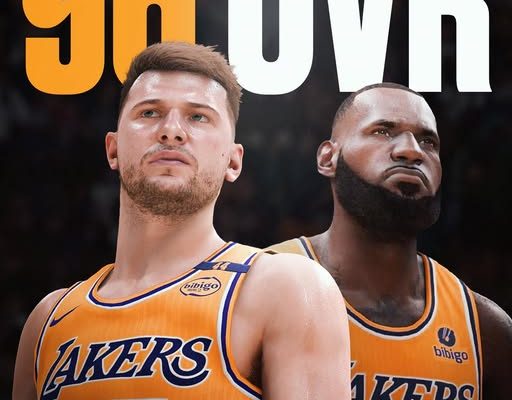In the ever-evolving world of NBA basketball, the annual release of NBA 2K ratings often stirs up passionate debate among fans, analysts, and even players. The latest installment of the iconic video game franchise, NBA 2K26, has done just that with the release of its player ratings, headlined by the controversial and headline-worthy decision to assign both LeBron James and Luka Dončić an overall rating of 96. This move has reignited discussions across social media platforms, sports talk shows, and forums, with opinions divided on whether this rating is justified, symbolic, or even a nod to the evolving narrative of basketball greatness. The pairing of LeBron James, a four-time NBA champion and widely regarded as one of the greatest players of all time, with Luka Dončić, a 25-year-old Slovenian phenom and statistical marvel, sends a strong message about where the league currently stands and where it’s headed.
For LeBron James, receiving a 96 overall rating is nothing short of remarkable given the stage of his career. Entering his 22nd NBA season, LeBron continues to defy the natural aging curve, putting up numbers that remain elite by any standard. In the 2024–25 season, he averaged 25.7 points, 7.3 rebounds, and 8.1 assists per game for the Los Angeles Lakers, while shooting over 50% from the field. These are not just good numbers for an aging superstar—they’re MVP-caliber stats in a vacuum. NBA 2K’s decision to bestow such a high rating on LeBron is an acknowledgment not only of his current on-court impact but also his cultural stature within the league. LeBron isn’t just a basketball player—he’s an institution. With his continued excellence and leadership, many view the 96 rating as a deserved honor, if not a conservative one.
Meanwhile, Luka Dončić’s inclusion at the same 96 overall rating is indicative of the torch being passed, albeit gradually. The Dallas Mavericks’ franchise cornerstone has firmly established himself as one of the league’s elite players, and he’s doing it with a blend of flair, vision, and scoring prowess rarely seen. Last season, Luka averaged a staggering 33.9 points, 9.8 assists, and 9.2 rebounds per game, flirting with a triple-double average over an 82-game season. His usage rate, ability to orchestrate an offense, and penchant for clutch performances have made him one of the most feared offensive weapons in the game today. By assigning Luka a 96 overall, NBA 2K is making a statement: Dončić is no longer a rising star—he’s here, he’s elite, and he’s competing with the titans of the game.
What makes this dual 96 rating particularly compelling is the narrative contrast between the two players. LeBron is the grizzled veteran, an icon whose presence alone commands respect. His rating can be seen as a symbol of sustained greatness—a player who has refused to fade even as younger stars emerge. Luka, on the other hand, represents the future. He is the prototype of the modern NBA superstar: positionless, analytically efficient, and a global brand. The 2K rating, then, becomes less about exact on-court ability and more about encapsulating an era in transition. The NBA is currently experiencing a generational overlap where the old guard still holds sway, but the new breed is knocking louder than ever.
Critics of the ratings argue that while LeBron is still playing at a high level, the idea that he is on the same tier as Luka, statistically, might be a stretch. Luka’s box score dominance, offensive load, and playmaking metrics eclipse nearly every other player in the league, including LeBron. Some believe Luka should have been rated higher—perhaps a 97 or even a 98—to reflect the statistical chasm between him and his peers. On the flip side, others argue that NBA 2K ratings are not purely mathematical but blend real-life impact, leadership, defensive prowess, and basketball IQ. In those categories, LeBron arguably still stands above nearly everyone in the league.
There’s also the emotional and marketing component of ratings. LeBron James remains the face of basketball globally. Regardless of age, his influence on the game, on his teammates, and on the broader cultural conversation of the NBA is unparalleled. NBA 2K, as a brand, benefits from tying its product to LeBron’s legendary stature. Similarly, Luka’s growing global fanbase, particularly in Europe, presents an opportunity for NBA 2K to signal its recognition of the international rise in basketball popularity. By putting both at 96, the game effectively creates a bridge between generations, geography, and styles of play.
Another intriguing angle is how these ratings impact player perception and even locker room dynamics. While NBA players often downplay the importance of 2K ratings publicly, there’s a mountain of evidence—social media reactions, post-game interviews, and off-season banter—that suggests they do care. Being rated in the top echelon by 2K is seen as a badge of honor. It signifies respect. For Luka, sharing a 96 with LeBron may serve as validation of his relentless work ethic and growing legacy. For LeBron, it may act as a reminder that his game still commands reverence, even as younger stars attempt to surpass him.
In terms of gameplay, the dual 96 rating gives gamers a unique choice when building franchises or competing online. Both LeBron and Luka bring different skill sets to the digital court. LeBron is the ultimate Swiss Army knife—elite in transition, a playmaker, a defender, and a finisher. Luka, meanwhile, offers a more cerebral approach—slowing the pace, using angles, stepbacks, and pinpoint passes to control the flow of the game. The gameplay mechanics have been updated in 2K26 to reflect these nuances, making both players formidable in different contexts. LeBron’s athleticism and defensive versatility make him an ideal two-way threat, while Luka’s stepback jumper and passing vision create open looks at will.
As with every edition of NBA 2K, the ratings are dynamic and will shift as the season progresses. It’s entirely possible that Luka could ascend to a 97 or higher if he maintains his dominance, or that LeBron could drop slightly should Father Time catch up to him in a visible way. But for now, this snapshot in time tells us something valuable about how the basketball world views its stars: LeBron James remains atop the mountain, and Luka Dončić is right there beside him, perhaps ready to climb even higher.
The inclusion of both players at the same rating also creates ripple effects among other superstars. Players like Nikola Jokić, Giannis Antetokounmpo, Joel Embiid, Jayson Tatum, and Stephen Curry all have strong cases to be ranked as high or higher. Jokić, in particular, continues to be the most efficient offensive player in the league, while Giannis’ two-way dominance remains unmatched. That LeBron and Luka share the highest rating—assuming no player is rated higher in the base game—will surely spark debate among fans of those other players. It’s a reminder that ratings, while rooted in performance, also reflect narrative, popularity, and legacy.
The historical significance of this shared rating can’t be ignored either. Few players in NBA 2K history have managed to remain among the highest-rated in the game into their 40s, and LeBron will be turning 41 during this NBA season. That he’s still considered a top-tier option in 2K is testament to his extraordinary career and conditioning. Luka, meanwhile, is just reaching his prime. The fact that they’re rated equally—despite a 16-year age gap—is unprecedented and speaks volumes about the unique paths their careers have taken.
Ultimately, the decision to rate both LeBron James and Luka Dončić at 96 in NBA 2K26 is more than a number—it’s a narrative device. It tells a story of transition, of respect, and of what it means to be a superstar in today’s NBA. Whether one agrees with the decision or not, it’s clear that both players have earned their place in the spotlight. LeBron, the enduring legend, and Luka, the relentless prodigy, are shaping the game in their own images. And for a basketball simulation game that prides itself on authenticity and cultural relevance, there’s perhaps no better way to honor them than to place them side by side—96 overall, shoulder to shoulder, icons of their respective times.



